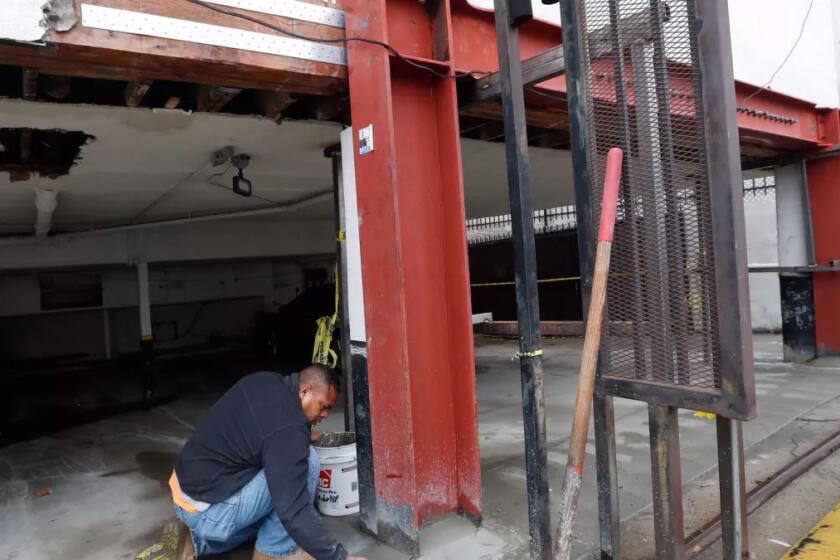California FEMA earthquake retrofit grants canceled, imperiling critical work, Schiff says

- Share via
- Program would have provided $33 million in grants to retrofit seismically vulnerable apartments.
- Sen. Adam Schiff says that money is essential to prepare for California’s next major earthquake, but the Trump administration canceled the funding program, calling it ‘wasteful and ineffective.’
The Trump administration has canceled $33 million worth of federal funds meant to help pay for earthquake retrofits in California — sparking “grave concern” and a call to reconsider from one of the state’s highest elected officials.
In a letter dated Wednesday, Sen. Adam Schiff (D-Calif.) urged U.S. Homeland Security Secretary Kristi Noem to reinstate the funds, which would’ve been used to strengthen between 750 and 1,500 apartment buildings.
“In California, earthquakes are not a question of if, but when,” Schiff wrote in his letter, addressed to both Noem and David Richardson, a senior official performing the duties of the FEMA administrator. “This move must be reversed before tragedy strikes next.”
The Earthquake Multi-Unit Soft-Story Retrofit grants — originally green-lighted through the Federal Emergency Management Agency, which is part of Noem’s department — were meant to help retrofit the kind of vulnerable apartment buildings that crushed people to death when they collapsed during California’s last major urban earthquakes.
These types of apartment buildings are ubiquitous across California’s major cities. They have flimsy supports on the ground story that prop up carports, garages or storefronts and can snap when shaken from side to side in an earthquake.

FEMA issued a statement on April 4 announcing the cancellation of the Building Resilient Infrastructure and Communities program, known as BRIC, that would have funded the California earthquake retrofits.
“The BRIC program was yet another example of a wasteful and ineffective FEMA program. It was more concerned with political agendas than helping Americans affected by natural disasters. Under Secretary Noem’s leadership, we are committed to ensuring that Americans in crisis can get the help and resources they need,” the agency’s statement said.
Officials and scientists have known for decades of the earthquake danger posed by soft-story apartment buildings.
Amid Southern California’s most seismically active year in decades, some cities have yet to require retrofits of many apartment buildings deemed most at risk of collapse.
Autopsy reports indicate that a number of those killed in these apartment collapses during the 1989 Loma Prieta earthquake and the 1994 Northridge earthquake died from suffocation. The weight of debris made it impossible for them to breathe.
Accounts from the collapse of the three-story, 163-unit Northridge Meadows apartment building in 1994 describe some victims in ground-floor units slowly dying in their beds, not able to breathe as the weight of the upper two stories pressed upon them.
Sixteen people, ranging from age 14 to 80, died in the Northridge Meadows collapse. In all, that magnitude 6.7 earthquake seriously damaged or destroyed about 200 soft-story buildings across the Los Angeles area.
In San Francisco’s Marina District, seven apartment buildings collapsed during the magnitude 6.9 earthquake in 1989. Three people died in a four-story apartment building in which the top two stories collapsed onto the second floor, according to coroner’s documents. A couple, age 48 and 40, died. A 3½-month-old also died when a stairway collapsed as his mother tried to flee the building with him.

A U.S. Geological Survey report published in 1998 said that “soft-story” apartments were “surprisingly vulnerable to becoming uninhabitable” in both the 1989 and 1994 earthquakes. Of the 16,000 housing units rendered uninhabitable in the Loma Prieta earthquake, 7,000 were soft-story. The same was true of 11,000 out of the 48,000 units made uninhabitable in the Northridge quake.
The California Residential Mitigation Program was counting on federal FEMA grants to fund retrofit work on soft-story apartments. In late 2024, program officials said they hoped to offer grants to apartment owners in cities that already have mandatory retrofit laws for these buildings. The initial focus was planned to be on areas with socially vulnerable populations.

“By eliminating this critical source of federal funding, we are leaving those who can least afford it at the greatest risk of displacement, which could cost lives,” Schiff wrote in his letter.
Had BRIC not been canceled, the California Residential Mitigation Program planned to make retrofit grants available to owners of buildings in the following cities with mandatory soft-story retrofit laws: Los Angeles, Torrance, Pasadena, Burbank, Santa Monica, Culver City, West Hollywood and Beverly Hills; and in Northern California, San José, San Francisco, and Oakland.
A common retrofit technique for soft-story buildings is to install steel frames on the ground story.
Once considered politically impossible because of cost, requiring owners to retrofit their buildings gets overwhelming support from L.A. residents.
BRIC grant funds that haven’t yet been distributed to states, tribes, territories or local communities would be returned to the U.S. Treasury or FEMA’s Disaster Relief Fund, according to the agency. The statement said about $882 million will be returned or reapportioned by Congress in the next fiscal year.
“FEMA estimates more than $3.6 billion will remain in the Disaster Relief Fund to assist with disaster response and recovery for communities and survivors,” the statement said.
BRIC was originally created in 2018 — during President Trump’s first term — through the Disaster Recovery Reform Act, according to the American Society of Civil Engineers, which supported the program. The goal, that organization says, was “to ensure a stable funding source to support” projects that seek to reduce the risk from future natural disasters. BRIC replaced a similar FEMA program, called the Pre-Disaster Mitigation program.
“BRIC supported projects such as flood control systems, wildfire prevention, stormwater management upgrades, and strengthened building codes. The program typically covered up to 75% of project costs and awarded more than $5 billion in grants,” according to the civil engineers society.
Experts say recent turmoil at FEMA will leave millions of people vulnerable as climate change-fueled disasters get worse in the months and years ahead.
BRIC received a boost during the Biden administration following passage of the Infrastructure Investment and Jobs Act, which authorized an additional $1 billion in funding over five years, the civil engineers society said.
The Biden administration in 2021 hailed the expansion of BRIC’s funding as a way for states and other local governments “to proactively reduce their vulnerability to natural hazard events before they occur.”
The California Governor’s Office of Emergency Services has identified up to $870 million in BRIC projects statewide that will lose federal funding. In Southern California, potential losses include:
- $46.3 million for San Bernardino County’s Inland Empire recycled water and aquifer storage project
- $36.4 million for San Bernardino County’s Flood Control District Mission Channel project
- $16 million for stabilization work for the landslide in Rancho Palos Verdes
- $15 million for San Bernardino County’s Cable Creek Basin flood mitigation project
- $9.8 million for a shoreline adaptation project in Orange County
Rancho Palos Verdes’ financial woes are mounting after losing a $16-million FEMA grant that was supposed to help with landslide stabilization.
Other major projects statewide that stand to lose money include $29.7 million for climate change resiliency in Yuba County, $32 million for wildfire retrofitting in Nevada County, $35 million for wildfire mitigation in Napa County, $37 million for wildfire resiliency in Sonoma County and $37.9 million for wildfire resiliency in Mendocino County.
Also in jeopardy is up to $50 million in funding apiece for a Port of San Francisco coastal resilience project, a flood protection project for the Menlo Park area, a flood adaptation project in Oakland and Alameda, a Sutter Bypass levee project in the Central Valley, for water supply resiliency for the city of Riverbank in Stanislaus County, and for infrastructure resiliency for the city of Pacifica in San Mateo County.
The cancellation of BRIC funding will not affect California’s earthquake retrofit grant programs for single-family homes, which are called Earthquake Brace + Bolt and Earthquake Soft-Story, according to Stephanie Stephens, managing director for the California Residential Mitigation Program.
Grant funding for retrofits for single-family homes comes from a different source — FEMA’s Hazard Mitigation grant program.
“We continue to process these grants as usual,” Stephens said.
More to Read
Sign up for Essential California
The most important California stories and recommendations in your inbox every morning.
You may occasionally receive promotional content from the Los Angeles Times.
















